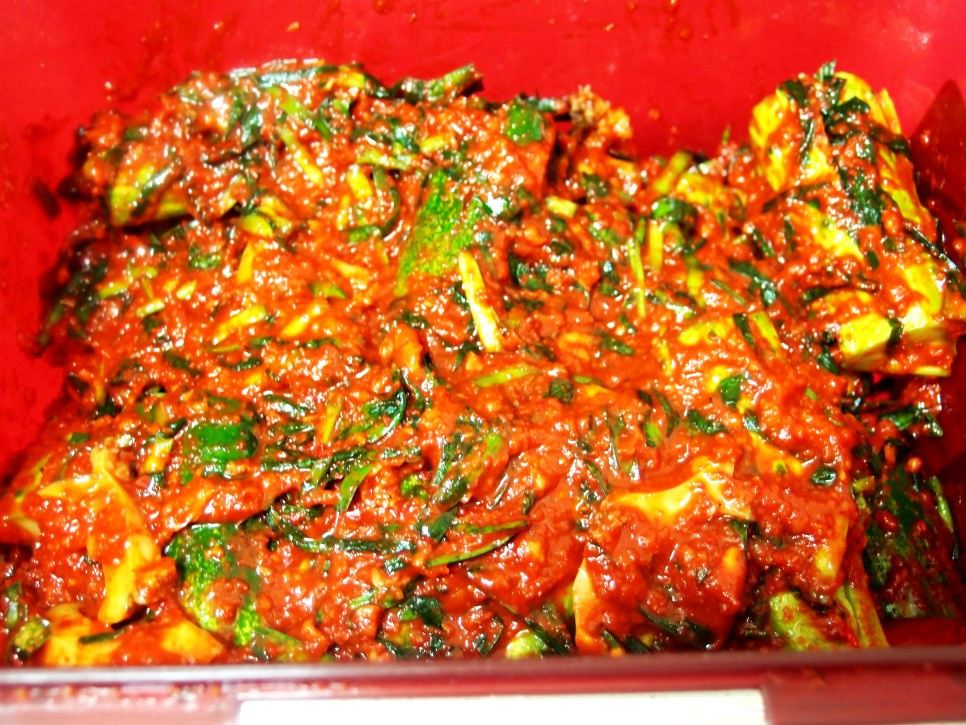Chewy Abalone Stuffed Cucumbers (Oisobagi)
#Pyeonstorang #LeeJeongHyeon #AbaloneOisobagi #FavoriteSideDish #FreshlyMadeOisobagi!!

Introducing a special abalone oisobagi recipe from Chef Lee Jeong-hyeon’s ‘Pyeonstorang’! This dish elevates the classic crunchy oisobagi with the chewy texture and rich flavor of abalone, creating a truly delightful culinary experience. This recipe is designed for simplicity, using just chives, abalone, and kimchi seasoning for an easy preparation. Unlike traditional oisobagi, the abalone is mixed with the seasoning before stuffing, ensuring the abalone itself absorbs the kimchi flavors thoroughly. It’s perfect for enjoying fresh, like a kimchi salad, or can be slightly fermented for a deeper taste. (Note: Due to the cost of abalone, the quantity was adjusted for the 6 cucumbers prepared.)
Main Ingredients- 4 Abalone
- 1 tsp Coarse Sea Salt (for purging abalone)
- 6 Cucumbers
- 1 Tbsp Coarse Sea Salt (for salting cucumbers)
- 1/2 bunch Chives (approx. 100g)
- 3 Tbsp Gochugaru (Korean chili powder)
- 3 Tbsp Fish Sauce (Anchovy or Pollack)
- 1 tsp Minced Fermented Shrimp
- 2 Tbsp Minced Garlic
- 1 tsp Minced Ginger
- 3 Tbsp Plum Extract (Maesil Extract)
- 1 cup Dried Pollack Broth (or kelp/anchovy broth)
Cooking Instructions
Step 1
First, wash the chives thoroughly and cut them into approximately 4cm lengths. Then, combine all the kimchi seasoning ingredients: gochugaru, minced garlic, minced ginger, fermented shrimp, fish sauce, plum extract, and the dried pollack broth (or kelp/anchovy broth). Mix them well to create a delicious kimchi seasoning. Ensure all ingredients are thoroughly blended for optimal flavor.

Step 2
Wash the cucumbers under running water and trim off the ends. Make deep cross-shaped (+) cuts from one end almost to the other, stopping before the base. Sprinkle coarse sea salt evenly onto the cut surfaces and let the cucumbers salt for about 20-30 minutes. For faster salting, you can submerge the cucumbers in a saltwater brine. They are ready when they become pliable and bend easily.

Step 3
While the cucumbers are salting, it’s time to prepare the abalone. If you have fresh, live abalone, add about 1 teaspoon of coarse sea salt and gently rub the abalone for about 10 minutes to purge any sand or grit. (Note: If you plan to make other dishes like Abalone Gamtae Kimbap, prepare extra abalone at this stage.)

Step 4
After purging, rinse the abalone under running water to wash away any remaining dirt. Use the dull side of a knife or a clean brush (like a toothbrush or kitchen brush) to scrub the abalone thoroughly, especially between the shell and the meat. A steel wool scrubber can also be used.

Step 5
Even with fresh abalone, it’s best to blanch it briefly for safety and texture. Bring a pot of water to a boil, add a splash of soju (optional, for tenderness), and blanch the abalone for just 1-2 minutes. Be careful not to overcook, as this can make the abalone tough.

Step 6
Immediately after blanching, transfer the abalone to cold water to cool down. Once cooled, separate the meat from the shell and carefully remove the innards. Save the innards for dishes like the abalone kimbap’s egg garnish or other recipes by freezing them. The shells can be reserved for making broth later to add extra flavor.

Step 7
To the prepared kimchi seasoning, add the blanched abalone, thinly sliced into pieces. If you don’t have a lot of abalone, gently mix the sliced pieces with the seasoning. Mixing well ensures the abalone is coated with the kimchi flavor, completing the filling for your abalone oisobagi.

Step 8
The abalone kimchi filling is now ready. All that’s left is to stuff it into the salted cucumbers. This simple final step brings together the crunchy cucumbers and the chewy abalone for a delicious oisobagi.

Step 9
Rinse the salted cucumbers in cold water two to three times to remove excess salt. Drain them thoroughly in a colander. It’s crucial to remove as much water as possible, otherwise, the oisobagi might turn out bland.

Step 10
Carefully stuff the abalone kimchi filling into the cuts of the drained cucumbers. Use a spoon or your fingers to gently pack the filling into each cucumber slice.

Step 11
Voila! Your delicious abalone oisobagi is ready. It’s wonderful to enjoy fresh and crunchy right away. If you prefer a slightly more mature flavor, leave it at room temperature for one day, then transfer it to a kimchi refrigerator and let it ferment for 3 days before serving for a deeper taste.




